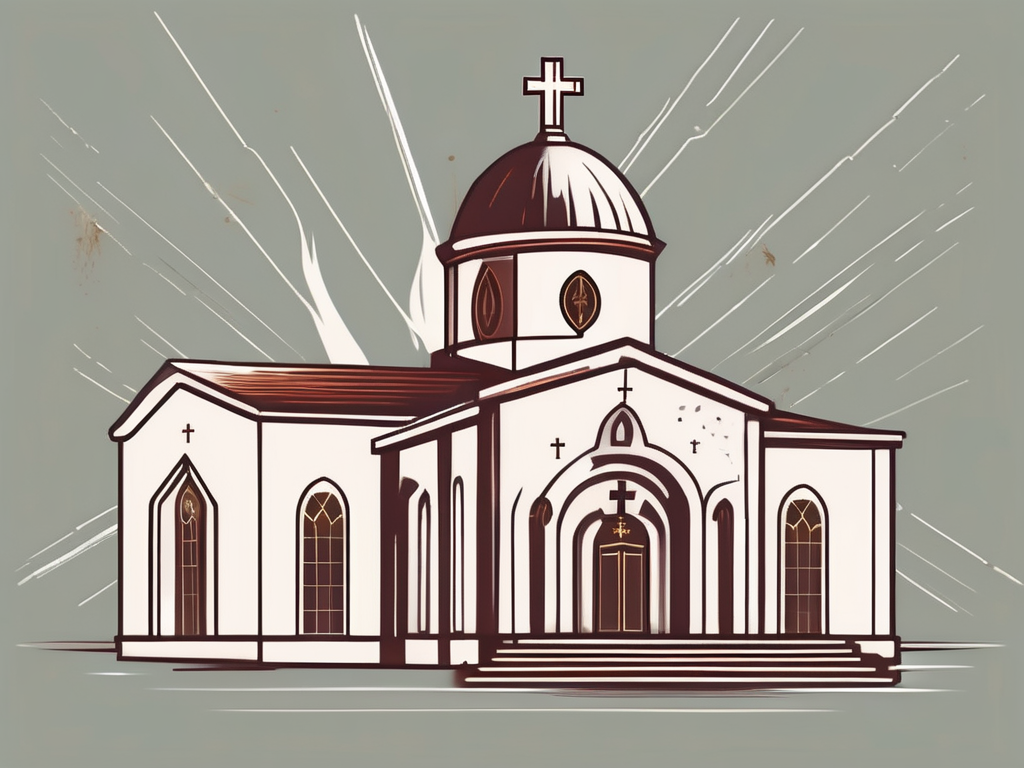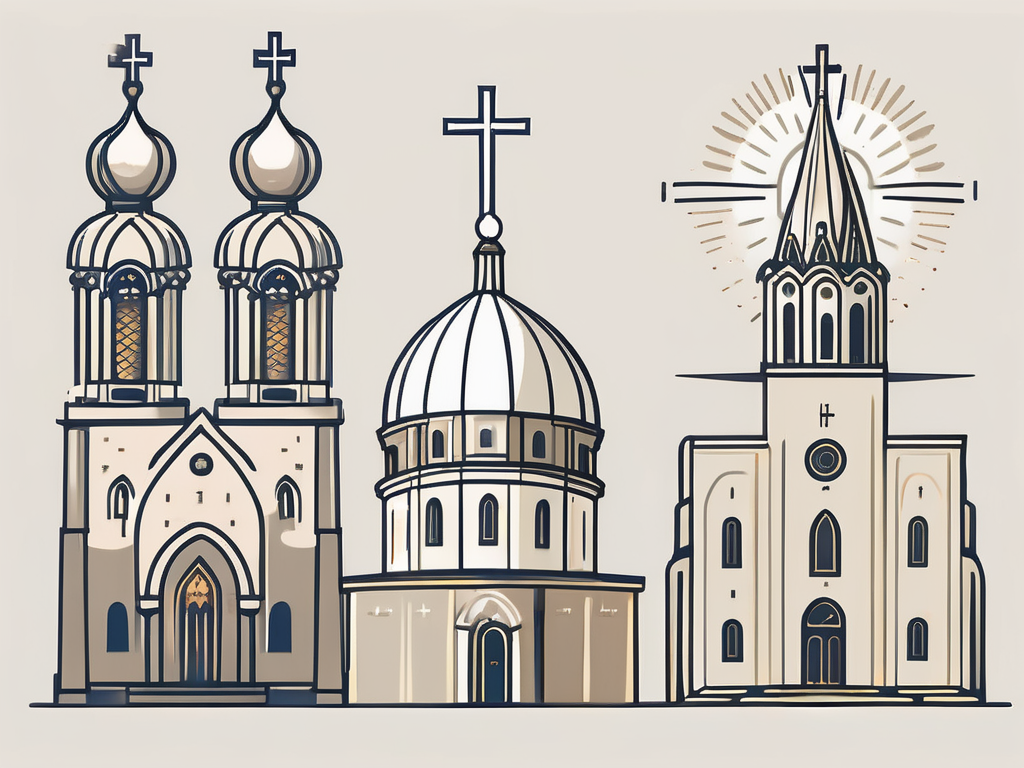When it comes to exploring different Christian traditions, the Eastern Orthodox and Evangelical denominations stand out as two significant branches that have shaped the faith in profound ways. In this article, we will delve into the core beliefs, practices, historical development, and societal perceptions of these two traditions to better understand their similarities and differences.
Understanding the Eastern Orthodox Tradition
The Eastern Orthodox tradition is a rich and ancient branch of Christianity. Rooted in the apostolic traditions, it places a strong emphasis on the sacraments, liturgy, and the authority of the Church. The Orthodox Church recognizes seven sacraments, including baptism, the Eucharist, and holy orders.
One key aspect of Eastern Orthodox theology is the concept of theosis, which teaches that humans can partake in the divine nature through a process of sanctification. The Church plays a pivotal role in guiding believers on this path of spiritual transformation.
The Eastern Orthodox tradition encompasses a vast array of theological beliefs and practices that have evolved over centuries. These beliefs and practices are deeply rooted in the writings of the early Church Fathers and the ecumenical councils. The Eastern Orthodox Church places a strong emphasis on the mystery of the Holy Trinity, the Incarnation, and the importance of icons in worship.
Icons, revered as windows into the divine, hold a special place in Eastern Orthodox worship. They aid believers in their prayer and meditation, serving as tangible reminders of the presence of God. The veneration of icons is not seen as idolatry, but rather as a means of connecting with the spiritual realm.
The liturgy in the Eastern Orthodox Church is a distinctive and deeply meaningful experience. The Divine Liturgy, the central act of worship, is a solemn and richly symbolic liturgical service that includes chants, prayers, and the distribution of the Eucharist. It is viewed as a participation in the heavenly worship and a means of communion with God.
The historical development and influence of the Eastern Orthodox Church are vast and far-reaching. The roots of the Eastern Orthodox Church can be traced back to the early Christian communities of the Byzantine Empire. Throughout history, the Orthodox Church has played a significant role in Eastern Europe, Russia, and parts of the Middle East.
The influence of Eastern Orthodoxy can be seen not only in religious practices but also in the arts, culture, and architecture of these regions. Byzantine architecture, with its distinctive domes and intricate mosaics, is a testament to the enduring impact of the Eastern Orthodox tradition.
Despite its distinct identity, the Eastern Orthodox Church has often found itself in tension with political powers, especially during the Byzantine and Ottoman Empires. This struggle for autonomy has fostered a strong sense of unity and resilience within the Orthodox Church, as it has persevered through centuries of challenges and adversity.
The role of clergy and laity within the Eastern Orthodox Church is well-defined and complementary. The hierarchical structure of the Church places the bishop as the central figure, regarded as the successor of the Apostles and the guardian of the faith within their diocese.
Below the bishop, there are priests and deacons who assist in the administration of the sacraments and the pastoral care of the faithful. The clergy play a vital role in leading worship, providing spiritual guidance, and preserving the traditions of the Church.
However, the laity are also considered essential members of the Church and are encouraged to actively participate in the life of the community. Laypeople contribute to the liturgy through their prayers, hymns, and responses, and they are encouraged to strive for personal holiness in their daily lives.
In conclusion, the Eastern Orthodox tradition is a vibrant and multifaceted expression of Christianity. Its rich theological beliefs, distinctive worship practices, and historical development have shaped the lives of millions of believers throughout the centuries. The Eastern Orthodox Church continues to be a source of spiritual nourishment and guidance for its faithful, inviting them to partake in the divine nature and strive for holiness.
Unpacking Evangelical Christianity
Evangelical Christianity, on the other hand, is characterized by a strong emphasis on personal faith, salvation through Jesus Christ, and the authority of the Bible. It emerged as a distinct movement during the Protestant Reformation and has since been influential globally.
Evangelical Christianity is a diverse and vibrant branch of Christianity that encompasses a wide range of beliefs and practices. While there are variations within the movement, there are some core beliefs and practices that are commonly shared among Evangelicals.
Core Beliefs and Practices
At the core of Evangelical Christianity is the belief in the Gospel message, emphasizing the need for faith in Jesus Christ as the only means of salvation. Evangelicals believe that Jesus’ death on the cross and resurrection provide forgiveness of sins and eternal life for those who trust in Him.
Evangelicals place a high priority on personal conversion, often expressing their commitment through a public profession of faith. This conversion experience is seen as a transformative moment in which individuals are born again and receive the Holy Spirit.
Prayer and study of the Scriptures are fundamental aspects of Evangelical spirituality. They believe in the inspiration and authority of the Bible, striving to apply its teachings to their daily lives. The Bible is seen as the ultimate source of truth and guidance for faith and practice.
Evangelicals also actively engage in evangelism, seeking to share the Good News of Jesus with others. They believe that all people are in need of salvation and have a responsibility to spread the message of God’s love and grace.
Historical Roots and Impact
Evangelical Christianity traces its roots back to the Protestant Reformation, particularly the teachings of Martin Luther, John Calvin, and other reformers who sought to return to the biblical foundations of faith. These reformers emphasized the importance of personal faith and a direct relationship with God.
The movement gained momentum during the Great Awakening in the 18th century, a period of religious revival characterized by passionate preaching and fervent worship. This revivalist spirit continues to shape Evangelical Christianity today, with an emphasis on personal piety and spiritual renewal.
Evangelical Christianity has had a significant impact on social, cultural, and political spheres. Evangelicals have been involved in various activism, mission work, and educational initiatives, seeking to live out their faith and bring about positive change. They have been at the forefront of movements advocating for social justice, human rights, and the sanctity of life.
Leadership and Community Involvement
Evangelical churches typically have a congregational or pastor-led model of leadership. The pastors are responsible for teaching, shepherding, and overseeing the spiritual needs of the congregation. They often play a central role in shaping the church’s vision and mission.
Community involvement is another hallmark of Evangelical Christianity. Churches often organize outreach programs, social justice initiatives, and community service projects to address the practical needs of individuals and foster positive change in society. This commitment to serving others is rooted in the belief that faith should be lived out in tangible ways.
Evangelicals also place a strong emphasis on the importance of community and fellowship. They believe that the church is a family of believers who support and encourage one another in their faith journey. Small groups, Bible studies, and prayer meetings are common ways in which Evangelicals connect with one another and grow spiritually.
In conclusion, Evangelical Christianity is a dynamic and diverse movement within Christianity. It is characterized by a strong emphasis on personal faith, salvation through Jesus Christ, and the authority of the Bible. Evangelicals are passionate about sharing the Gospel, engaging in prayer and Bible study, and making a positive impact in their communities.
Key Similarities and Differences
While the Eastern Orthodox and Evangelical traditions have distinct theological and liturgical practices, they also share some common ground.
When exploring the similarities and differences between the Eastern Orthodox and Evangelical traditions, it is important to delve into their doctrinal beliefs and practices, as well as their worship styles and community engagement.
Doctrinal Similarities and Differences
Both traditions affirm the central doctrines of Christianity, such as the Trinity, the Incarnation, and the need for salvation through Christ. However, they may differ in their theological emphases and interpretations of certain theological concepts.
For example, while the Orthodox Church places great emphasis on the sacraments and the mystery of the faith, Evangelicals tend to prioritize personal faith and a personal relationship with Jesus Christ. This difference in emphasis can be seen in their respective liturgical practices and spiritual disciplines.
The Eastern Orthodox tradition views the sacraments, such as baptism and the Eucharist, as tangible means of experiencing God’s grace and participating in the divine life. The sacraments are seen as transformative encounters with God, bringing believers into communion with Him and the Church.
On the other hand, Evangelicals emphasize the importance of personal faith and a personal relationship with Jesus Christ. They believe that salvation is received through faith alone and that individuals can have a direct and personal connection with God through prayer, Bible study, and worship.
While both traditions hold to the core doctrines of Christianity, their theological emphases and practices reflect different approaches to experiencing and expressing their faith.
Worship Styles: A Comparison
The worship styles of Eastern Orthodox and Evangelical churches are distinct in their approach. Orthodox worship is highly liturgical and sensory, incorporating incense, icons, chants, and symbolic gestures. The liturgy is carefully structured and follows a set order, creating a sense of reverence and awe.
Evangelical worship, on the other hand, is often characterized by contemporary music, congregational singing, and a more informal atmosphere. The focus is on heartfelt praise and worship, with an emphasis on personal expression and engagement.
Both approaches seek to facilitate encounters with God, providing different avenues for spiritual nourishment and expression. The Eastern Orthodox liturgy invites believers into a rich tapestry of ancient traditions and symbols, while Evangelical worship encourages individual and communal participation in a contemporary and dynamic setting.
These worship styles reflect the cultural and historical contexts in which the traditions developed, as well as the theological emphases of each tradition.
Community Engagement: Orthodox vs Evangelical
Both the Eastern Orthodox and Evangelical traditions espouse a commitment to serving others and participating in community life.
Eastern Orthodox communities often engage in acts of charity, social outreach, and the preservation of cultural heritage. They are deeply rooted in their local communities and often contribute to the well-being of society through educational, healthcare, and humanitarian initiatives. The Orthodox Church sees itself as a guardian of tradition and a source of stability and support for its members and the wider community.
Similarly, Evangelical communities are known for their involvement in various social causes, advocacy for human rights, and missions work. They endeavor to live out the teachings of Jesus by actively addressing societal needs and promoting justice and compassion. Evangelicals often prioritize evangelism and sharing the message of salvation, seeking to bring about personal and societal transformation through their faith.
Both traditions recognize the importance of engaging with the world and making a positive impact on society. While their approaches may differ, their shared commitment to serving others reflects a common desire to live out their faith in practical and tangible ways.
As we explore the similarities and differences between the Eastern Orthodox and Evangelical traditions, it becomes evident that while they have distinct theological and liturgical practices, they also share common ground in their commitment to the core doctrines of Christianity and their desire to worship God and serve others. The richness of these traditions lies not only in their differences but also in the ways they complement and challenge one another, contributing to the diverse tapestry of the Christian faith.
Societal Perceptions and Misconceptions
Despite their contributions and significance, both the Eastern Orthodox and Evangelical traditions have faced misconceptions and misunderstandings in wider society.
Common Misconceptions about Eastern Orthodox Christianity
One common misconception about Eastern Orthodoxy is that it is an outdated and overly ritualistic faith, detached from the realities of modern life. While the Orthodox Church certainly embraces liturgical traditions, it also engages with contemporary issues and seeks to address the spiritual needs of its adherents in the present moment.
Another misconception is that Orthodoxy is exclusively an ethnic or cultural tradition, primarily associated with Eastern European or Greek communities. While these communities have preserved and nourished the Orthodox faith, Orthodoxy is a global tradition with diverse followers from various cultural backgrounds.
Widespread Misunderstandings about Evangelical Christianity
Evangelical Christianity is often viewed as rigid, judgmental, and politically conservative. While there may be individuals and groups that hold such views within the Evangelical community, it is important to recognize the diversity of beliefs and practices within this tradition.
Furthermore, Evangelicals are sometimes criticized for their aggressive approach to evangelism or perceived lack of engagement with social justice issues. However, many Evangelicals actively work towards promoting social justice, advocating for human rights, and addressing systemic injustice in their communities.
Conclusion
As we have explored the Eastern Orthodox and Evangelical traditions, it is clear that they both make significant contributions to the tapestry of Christianity. While they have their distinct theological emphases, worship styles, and societal engagements, there are also common threads that bind them together.
Understanding and appreciating these different traditions can broaden our perspective of the Christian faith, fostering dialogue, unity, and respect among believers. As we continue to explore the beauty and diversity of Christian traditions, we are enriched in our understanding of God’s work in the world and our own spiritual journeys.












